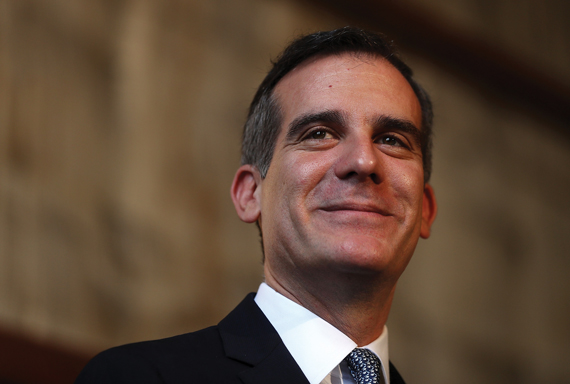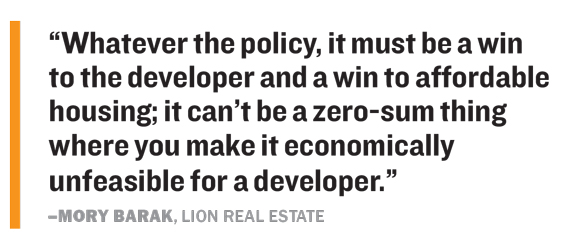Trending
Could Garcetti’s affordable housing plan hamper the market?

From the April issue: The March election awarded Mayor Eric Garcetti twin victories. In addition to successfully defending his seat for a second term, the mayor received a de facto stamp of approval for his housing policies. The defeat of Measure S and the passing of Measure H provided a green light for Garcetti to advance his plan to update the city’s aging community plans and put 100,000 new units on the market by 2021.
While industry players share Garcetti’s goals of expanding housing and resolving the city’s homelessness crisis, some market-rate developers worry about an increase in the cost of construction due to his proposed linkage fee initiative, which would levy taxes on new commercial and market-rate residential projects to help the city meet its affordable housing goals.
“There’s been a lot of productive discussion, but these policies, they’ll naturally take a long time to play out,” said a senior executive at a large local development firm, who spoke to The Real Deal on the condition of anonymity.
Competing interests
Perhaps the biggest source of tension in Garcetti’s housing plans is the balance between amassing the maximum amount of resources for affordable housing — whether it’s tax dollars or additional fees for entitlement — without driving market rate developers away, insiders told TRD. Proposition HHH gained overwhelming support in November, effectively authorizing $1.2 billion per year in bonds to build 10,000 units for the homeless. Since it would be paid through a slight increase in L.A. property taxes, that plan would not have a direct effect on the cost of construction. But a linkage fee — the proposal of which got two thumbs up from the Planning Commission in February — could wreak a little more havoc, developers say.
In its current draft, the linkage fee ordinance would require developers to pay $12 per square foot for residential projects and $5 per square foot for commercial projects. Builders of single-family houses larger than 1,500 square feet would also be required to pay the fee.
 Making projects more expensive for developers contradicts the goal of adding more housing, said Jeff Weller and Mory Barak, principals of development firm Lion Real Estate.
Making projects more expensive for developers contradicts the goal of adding more housing, said Jeff Weller and Mory Barak, principals of development firm Lion Real Estate.
“It’s a ridiculous idea because construction is already too expensive,” Barak told TRD. “Whatever the policy, it must be a win to the developer and a win to affordable housing; it can’t be a zero-sum thing where you make it economically unfeasible for a developer.”
Con Howe, the managing director of CityView and former director of planning for the city, said the ordinance won’t have a negative impact if all competitors in the market will be paying the same fees, keeping the playing field even for all.
But Central City Association president Jessica Lall argues that the city should prioritize streamlining the planning process, which she said would do more to aid achieving affordable housing goals than extracting money from developers.
“If you create more certainty on cost, there would be even more funding available to the community, and [a higher likelihood] of that revenue stream going toward their intentional purposes,” Lall told TRD.
According to Garcetti’s housing policy specialist Ben Winter, the administration is already working on improvements to the entitlement and planning process, like a priority qualification that saves builders six months of waiting for approvals. Garcetti also enacted the parallel design permitting process in 2015, which allows builders to start construction before the design of the project is finalized, reducing the construction timeline by up to nine months.
Ex-parte
On March 9, just one day after the election, Garcetti issued his latest executive directive, which among other things banned ex-parte communication between developers and the nine members on the planning commission, who are all appointed by the mayor.
The directive addressed one of the concerns raised by supporters of the defeated Measure S, which had also sought to discourage the chumminess between city officials and real estate stakeholders.
Some developers doubt that the new rule will impact the current entitlement process.
“It’s too early to tell on that front whether the ban will change anything major,” said Tommy Newman, a spokesperson for L.A. Family Housing, a nonprofit affordable housing development firm.
Howe suggested that the stink made over private conversations between officials and the industry was overblown in the first place.
“There may be a conspiracy theory out there that everything is a whisper in someone’s ear, and I think that there’s very little of that. Most of the discussion on projects is in front of people and in public,” he told TRD, adding that CityView has never approached a planning commissioner in private.
Up ahead
Garcetti is pushing for a revision of the density bonus incentive program (enacted in 2008) to more effectively encourage developers to build below-market-rate units while pursuing other measures to combat the housing crisis, Winter said.
More than just increasing supply, “we’re looking at the cost of housing and how to focus on affordability ethically so that vulnerable populations can remain in L.A.”
The minimum wage increase, for instance, according to Winter, plays a part in solving the housing crisis.
But critics say the mayor is not doing enough to protect tenants in existing affordable units. Some advocates are calling for reform of the Ellis Act, a state law that allows landlords to kick out tenants of a rent-controlled building if they change the use of the property or plan to demolish it.
In 2016 alone, 1,400 rent-controlled units were stripped from the market under the Ellis Act, a recent study from the Center for Economic Survival found — a 27 percent increase from 2015 figures.
Meanwhile, affordable housing developers are having a banner year.
“Proposition HHH has already been paying out dividends,” Newman said. L.A. Family Housing received $1.3 million in grants, which it will funnel into renovations at the bridge housing buildings on Lankershim Boulevard.
Still, their market-rate counterparts remain somewhat ambivalent about the affordable housing policies, with fingers crossed that market forces can prevail regardless of policy.
“This has been one of the best years for real estate development, but most of that has been market-driven, and the city has been doing their best to keep up with it. It’s hard to separate what accounts for the success,” said the development executive who wished to remain anonymous.




